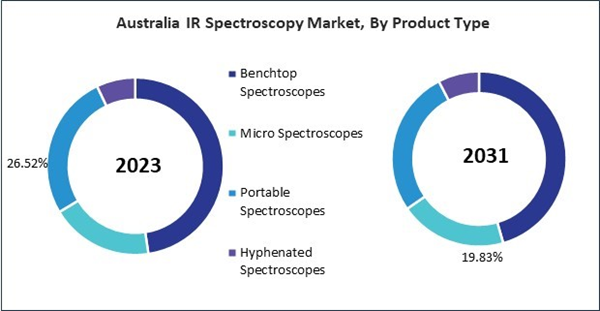The China market dominated the Asia Pacific IR Spectroscopy Market by Country in 2023, and would continue to be a dominant market till 2031; thereby, achieving a market value of $134.2 million by 2031. The Japan market is registering a CAGR of 6.4% during (2024 - 2031). Additionally, The India market would experience a CAGR of 7.8% during (2024 - 2031).
Irradiation of a sample with infrared radiation spanning a range of wavelengths, typically between 2.5 and 25 micrometers (μm), constitutes IR spectroscopy. The sample absorbs specific wavelengths of infrared radiation corresponding to the vibrational frequencies of the chemical bonds present in the molecules. By analyzing the pattern of absorption bands in the resulting infrared spectrum, valuable information about the sample's molecular composition, functional groups, and structural characteristics can be obtained. IR spectroscopy is widely used in various fields, including chemistry, biochemistry, pharmaceuticals, materials science, environmental science, forensics, and food analysis.
Infrared spectroscopy is a versatile analytical technique used to study the molecular composition and structure of materials by measuring the absorption, emission, or reflection of infrared radiation. This method operates on the principle of the interaction between molecular vibrations within a sample and infrared radiation. When molecules absorb infrared radiation, the vibrational energy levels of their chemical bonds change, leading to characteristic absorption bands in the infrared spectrum.
The Asia Pacific region is a leader in the food and beverage sector and electronics industry. The rapid expansion of these industries is driving the demand for IR spectroscopy technologies. In India, the food processing sector is a major driver of the expanding IR spectroscopy market. Combined with the versatile applications of IR spectroscopy, these factors are expected to fuel further growth in the region's market.
Based on Technology, the market is segmented into Dispersive and Fourier Transform. Based on Type, the market is segmented into Near-infrared Spectroscopy, Mid-infrared Spectroscopy, and Far-infrared Spectroscopy. Based on Product Type, the market is segmented into Benchtop Spectroscopes, Micro Spectroscopes, Portable Spectroscopes, and Hyphenated Spectroscopes. Based on End-user, the market is segmented into Healthcare & Pharmaceuticals, Chemicals, Food & Beverages, Biological Research, Environmental, and Consumer Electronics. Based on countries, the market is segmented into China, Japan, India, South Korea, Australia, Malaysia, and Rest of Asia Pacific.
List of Key Companies Profiled
- Shimadzu Corporation
- Carl Zeiss AG
- Revvit, Inc
- Agilent Technologies, Inc.
- Bruker Corporation
- ABB Group
- Thermo Fisher Scientific, Inc.
- Horiba Ltd.
- Sartorius AG
- Hitachi High-Tech Corporation (Hitachi, Ltd)
Market Report Segmentation
By Technology- Dispersive
- Fourier Transform
- Near-infrared Spectroscopy
- Mid-infrared Spectroscopy
- Far-infrared Spectroscopy
- Benchtop Spectroscopes
- Micro Spectroscopes
- Portable Spectroscopes
- Hyphenated Spectroscopes
- Healthcare & Pharmaceuticals
- Chemicals
- Food & Beverages
- Biological Research
- Environmental
- Consumer Electronics
- China
- Japan
- India
- South Korea
- Australia
- Malaysia
- Rest of Asia Pacific
Table of Contents
Companies Mentioned
- Shimadzu Corporation
- Carl Zeiss AG
- Revvit, Inc
- Agilent Technologies, Inc.
- Bruker Corporation
- ABB Group
- Thermo Fisher Scientific, Inc.
- Horiba Ltd.
- Sartorius AG
- Hitachi High-Tech Corporation (Hitachi, Ltd)









